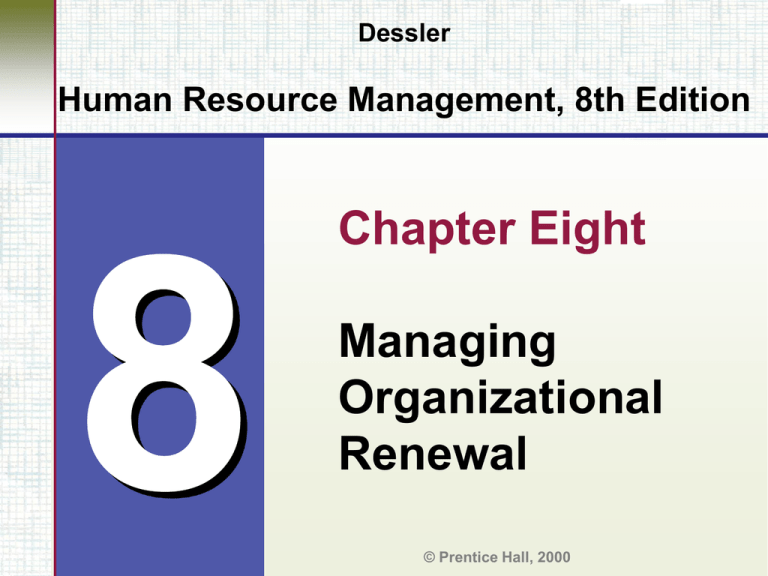No Slide Title - Departamento de Industria y Negocios
advertisement

Dessler Human Resource Management, 8th Edition Chapter Eight Managing Organizational Renewal © Prentice Hall, 2000 Behavioral Objectives When you finish studying this chapter, you should be able to: Discuss how to manage an organizational change program. Explain how to set up and manage total quality management programs. Describe how to create effective self-directed teams. Discuss HR’s role in business process reengineering. © Prentice Hall, 2000 Chapter 8 1 Types of Change Strategic Change Cultural Change Structural Change Task Redesign Technological Change Changes in People, Attitudes and Skills © Prentice Hall, 2000 Chapter 8 2 Ten Step Process for Leading Organizational Change 1. Establish a Sense of Urgency 2. Mobilize Commitment to Change through Joint Diagnosis of Business Problems 3. Create a Guiding Coalition 4. Develop a Shared Vision 5. Communicate the Vision 6. Enable Employees to Facilitate the Change 7. Generate Short-Term Wins 8. Consolidate Gains and Produce More Change 9. Anchor the New Ways of Doing things in the Company’s Culture 10. Monitor Progress and Adjust the Vision as Required © Prentice Hall, 2000 Chapter 8 3 Organizational Development (OD) Organizational development (OD) is a special approach to organizational change in which the employees themselves formulate the change that’s required and implement it, often with the assistance of a trained consultant. © Prentice Hall, 2000 Chapter 8 4 Types of OD Applications Human Process Applications Team Building Technostructural Interventions Human Resource Management Applications Strategic Applications © Prentice Hall, 2000 Chapter 8 5 Quality Quality can be defined as the totality of features and characteristics of a product or service that bears on its ability to satisfy given needs. © Prentice Hall, 2000 Chapter 8 6 Total Quality Management Programs Total quality management (TQM) programs are organizationwide programs aimed at maximizing customer satisfaction through continuous improvements. © Prentice Hall, 2000 Chapter 8 7 Human Resource Management and the Quality Improvement Effort Make sure all teams work within a policy—deployment process to ensure their efforts are consistent with the firm’s goals. Do not institute quality improvement teams as separate, parallel organization structures. Do not treat the quality improvement program as if it has an end. Recognize that training is essential. Give employees the skills they need to analyze and solve problems. Remember that whether or not the company achieves it’s quality goals is important but almost secondary. The new employee values that emerge are the heart of the program. © Prentice Hall, 2000 Chapter 8 8 Human Resource Management and the Quality Improvement Effort (Cont.) Don’t focus exclusively on “boosting productivity” or assume that emphasizing quality means that productivity will necessarily fall. Recognize effort and encourage employees. Reward individuals and team efforts in a concrete manner, not necessarily just with money but with rewards like merchandise or pins. Remember that the first steps need to be taken by top management. © Prentice Hall, 2000 Chapter 8 9 How HR Helps to Build Productive Teams Establish urgent, demanding performance standards. Select members for skill and skill potential. Train leaders to “coach” not “boss”. Challenge the group regularly with fresh facts and information. Exploit the power of positive feedback, recognition, and reward. Choose people who like teamwork. Train, train, train. Cross-train for flexibility. © Prentice Hall, 2000 Chapter 8 10 Business Process Reengineering Business process reengineering is “The fundamental rethinking and radical redesign of business processes to achieve dramatic improvements in critical, contemporary measures of performance such as cost, quality, service, and speed.” © Prentice Hall, 2000 Chapter 8 11 HR’s Role in Reengineering Process Building Commitment to Reengineering HR and Team Building HR’s Role in Changing the Nature of the Work HR’s Role in Moving from Controlled to Empowered Jobs HR’s Role in Moving from Training to Education © Prentice Hall, 2000 Chapter 8 12







